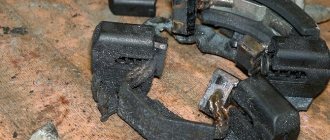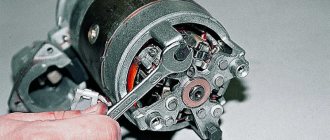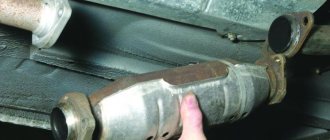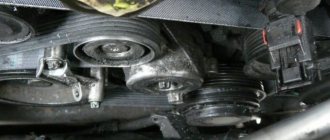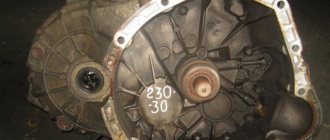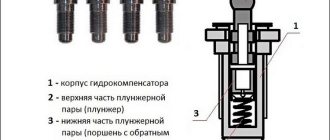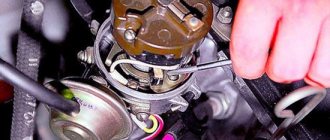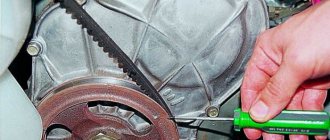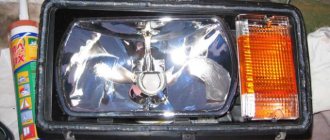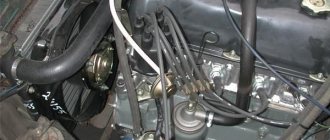The starter is not the most complex and expensive unit to maintain.
But it is one of the key components of the car. You turn the ignition key, the lights on the dashboard are on, but the starter does not turn, the engine does not start? There are two reasons:
- faulty contact supplying current to the starter relay;
- The starter itself or the relay is faulty.
In the second case, the starter must be removed, checked, repaired and reinstalled. The repair process is quite complex and deserves a large separate article. Here we will tell you how to replace the VAZ 2107 starter (carburetor, injector) and check its performance.
Assessing the scale of the problem
If, when you turn the key in the ignition switch, the starter does not turn, no clicks or sounds are heard, then the reason may be this:
- the battery is discharged or faulty;
- battery contacts are oxidized;
- problem with the contacts of the starter itself;
- a break in the windings of the device or the electrical circuit of the car.
When the starter turns slowly, clicks of the traction relay are heard, the reason may be this:
- there is a charge in the battery, but it is not enough to properly spin the moving parts of the starter;
- carbon deposits have formed on the contacts or they have oxidized;
- worn brushes or burnt commutator;
- short circuits in windings or brush holders.
Starter brush wear
Repeated operation of the relay and its spontaneous shutdown can be caused by a voltage drop in the network due to oxidized contacts or a malfunction of the traction relay. When the starter turns, but the flywheel does not rotate, there may be several reasons:
- problem with the freewheel (Bendix);
- drive or flywheel teeth are damaged;
- The bearings or springs of the traction relay are worn out.
These are perhaps the main malfunctions and their most common explanations. They are equally valid for carburetor models and injectors.
Conclusion
Every driver is interested in how much a regular and gear starter costs. In fact, the price is almost identical. The price of a regular one fluctuates around 3,500 rubles, and a geared one – 4,000 rubles. Considering this fact, it is of course more profitable to purchase a device that can breathe new life into the car. Considering that the installation and dismantling process will be carried out with your own hands, you will be able to save a lot.
A car starter is the main element of the engine starting system, and is designed to start it by cranking the crankshaft.
Essentially, it is a direct current electric motor driven by closing an electrical circuit by turning the ignition key. The autostarter consists of a stator, an armature (rotor), a brush holder with brushes, as well as a traction relay and a drive.
In all VAZ classic models, incl. and in the “seven”, it is located at the bottom of the engine, and is attached to the clutch housing.
What is a VAZ 2107 starter and how to change it?
A faulty VAZ 2107 starter causes the engine to simply stop starting.
When the key is turned in the ignition switch, the electrical circuit is closed, but the starter itself does not fire, so no force is transmitted to the crankshaft and it simply does not turn.
There can be many reasons why this happens, ranging from a banal short circuit in the car’s electrical system, to failure of the starter rotor winding or mechanical wear of the brushes. How to properly disassemble and repair a VAZ 2107 starter?
Starter device for a VAZ 2107 car
The design of the VAZ 2107 starter is to some extent reminiscent of an ordinary electric motor. The basis of the design is the so-called shoe, which is driven by the rotor.
t, in turn, begins to rotate when a voltage of 12 V is applied to it. This is the so-called gear starter. An ordinary electromagnet, which consists of an insulated copper winding, a metal core and brushes, is responsible for generating the magnetic field.
On the VAZ 21074 car, a similar scheme is used, but a slightly different fastening is used - 3 bolts each. The brushes transmit voltage to the rotor. They wear out not only due to friction, but also due to the high current generated by the coil.
The starter switching relay, located with it in a single housing, is responsible for the supply of electricity and timely shutdown of the shoe.
The operating principle of the classic starter on the VAZ 2107 is extremely simple: the device is connected to the crankshaft. When voltage is applied to the rotor, it spins and turns the fists.
As a result, the engine starts, after which power is supplied to the spark plugs from the generator, and not from the battery.
During an emergency engine start, a similar scheme is used - artificial cranking of the crankshaft.
It is not always the case that the engine does not start due to a faulty starter. It is possible that the problem lies in the wiring. Therefore, the first step is to study the starter connection diagram and all underwater wiring for a break. If one is found, the area will have to be replaced. At the same time, it is advisable to check the operation of the fuse (it is located on the left side of the hood).
It should also be mentioned that in some starter models protection is installed - this is an additional relay that automatically turns off the traction and prevents the supply of electricity from the battery even when the engine is running. These were not included in the factory configuration, but many install them after a certain period of operation.
VAZ 21074 starter relay where is it located
Housing type - with bracket 12V 30A 85 Ohm IP44
113.3747-10 - ? 90.3747-10 - old, not produced, without resistor 902.3747-10 - old, not produced, with resistor
Mostly AVAR on sale: 75.3777-10 - without resistor, 30A, IP44 752.3777-10 - with resistor, 30A, IP44
756.3777-10 - 40A, with a resistor, IP66 - sealed housing and high operating current, make this relay an excellent choice, for which you don’t mind overpaying, but I didn’t find them on sale (((((
- The engine does not start, the starter is completely silent, VAZ 2105 – 3 answers
- The voltage regulator fails on a VAZ 2107 - 5 answers
- The starter cannot crank the engine 2107 - 4 answers
- The starter does not turn the key on the VAZ 2107 - 3 answers
- The right window regulator on the VAZ 2107 does not work - 3 answers
To turn on the starter, use relays 113.3747-10 or 90.3747-10 with a bracket on the cover.
The starter relay on the VAZ-2107 is installed in the engine compartment on the right mudguard
There is no fuse for starting, the ignition switch, starter relay, or the starter itself may be faulty. From now on, describe the problem in more detail, we can answer in more detail.
Unlike previous “classic” models, the VAZ 2107 has an additional element in the starter control circuit - a starter relay. Like any car part, the relay can fail, making it impossible to start the engine. You can identify and fix the malfunction yourself; to do this, it is enough to know where the starter relay is located on the VAZ 2107 and have a minimum of tools for checking and replacement.
Why do you need a VAZ 2107 starter relay?
The starter traction relay on all classic models, except the VAZ 2107, was switched on directly through the ignition switch. The problem is that when it is turned on, a current of more than 15A passes through the contacts on the ignition switch, which over time leads to their oxidation, heating and failure. To reduce the current passing through the ignition switch when the starter is turned on, the designers of the “Seven” provided an additional element - the VAZ 2107 starter relay. The small current required for its operation does not harm the contacts of the ignition switch, and the relay itself more reliably switches the power to the starter traction relay . Often, owners of older “classic” models, tired of regularly changing the contact group of the ignition switch, independently install an additional relay that allows them to increase the service life of the contacts responsible for turning on the starter.
Where is the starter relay located on the VAZ 2107
The designers provided for the installation of a starter relay on the VAZ 2107 on the right side of the engine compartment. It is attached directly to the right wing, for which a stud is installed on the wing, onto which the relay mounting nut is screwed.
The easiest way to find it is to trace where the wires from the starter traction relay go.
How to check the VAZ 2107 starter relay
To check the functionality of the relay, you need a voltmeter or “control”. The functionality check is performed as follows:
- remove the wire block from the relay; check whether the contacts on the relay and the block are oxidized;
- clean contacts if necessary;
- make sure there is ground on the wire going to contact “86” of the relay;
- check whether voltage appears on the wire going to terminal “85” of the relay if you try to start the car with the key;
- make sure that when the ignition is turned on, voltage is supplied to the wire going to terminal “30”;
- if there is voltage at the terminals, the problem is in the relay, not in the power supply;
- remove the starter relay from the car;
- make sure that when voltage is applied to terminals “85” and “86”, the contact between “30” and “87” relay terminals is closed.
If the relay does not operate, it must be replaced with a new one.
Replacing the VAZ 2107 starter relay
To replace the VAZ 2107 starter relay, you will need a 10mm wrench. To replace the relay, you must perform the following steps:
- disconnect the ground wire from the battery by removing the negative terminal;
- Using a wrench, unscrew the nut holding the relay on the right wing;
- remove the starter relay;
- install a new relay;
- screw in and tighten the fastening nut with a wrench;
- connect the wire block to the relay;
- connect the ground wire to the battery.
This completes the replacement of the VAZ 2107 starter relay. It remains to check its operation by turning the ignition key.
Work order
- We place the car on a viewing hole or overpass and secure it with the parking brake.
- Open the hood and disconnect the ground wire from the battery.
- Using a 10mm socket, unscrew the bolt of the lower fastening of the starter heat shield.
- We dismantle the air filter housing and the warm air supply hose (for injection units, remove the fastenings of the intake pipeline).
- Using a socket wrench with a 13 mm extension, unscrew the 3 bolts securing the starter housing. It is better to unscrew the bottom bolt from the inspection hole.
- Using a 13mm wrench, unscrew the nut (on the injection engine there are two nuts) securing the starter shield. Let's take it out.
- Using a socket wrench with a 13 mm extension, unscrew the 3 bolts securing the starter housing. It is better to unscrew the bottom bolt from the inspection hole.
- Using the same tool, unscrew the nut securing the tip of the wire going to the “+” battery.
- Disconnect the start relay wire.
- We remove the starter from the rear wall of the engine compartment.
- We install a new starter in its place.
- We carry out installation work in reverse order.
What to do first?
Disassembling the mechanism is not a priority task, since the starter’s power supply is connected to the battery, so you need to start with it. If the car is not too old, it is unlikely that the problems will lie in the design of the starter itself. It is enough to clean the contacts of the battery or the device itself for everything to work again in the desired mode.
Difficulties begin when the machine has worked for a long time and its operation has not been delicate. If, after a complete check of the electrical equipment of your VAZ 2107, the starter still does not start or continues to work intermittently, then the reason is inside the device and it is necessary to remove and disassemble the starter. On this model, both in carburetor and injection versions, it is installed rather inconveniently. To get to it normally, you will have to drive the car onto an overpass or inspection hole.
Disassembling the VAZ 2107 starter
After the ignition is turned off, you can begin the “operation”. It must be done in the following order:
- remove the ground terminal from the battery;
- if there is a protective mud casing at the bottom, then it must be dismantled;
- remove the electrical wires from the solenoid relay;
- unscrew the three mounting bolts (two upper, one lower);
- remove the starter.
As you can see, nothing complicated. The only thing is that in the case of an injection model, mechanics advise removing the inlet pipe extensions as well. Now we have to disassemble the device itself.
Solenoid relay diagnostics
The malfunction of the VAZ 2107 starter, regarding clicks and refusal to turn, may lie in the relay. The relay is connected using two cables that go to the ignition switch and to the battery. One cable is connected to the battery terminal (+), the other to the ignition terminal (+). There is another wire that connects the relay to the starter drive.
To identify the cause of the breakdown of the solenoid relay, you need to use a jumper with which to connect both terminals. The connection itself should be made using a regular screwdriver or other convenient tool. It is important that the jumper does not touch other metal surfaces when making a connection.
Detailed installation process
In order to correctly install the starter, you must adhere to the following points:
1. Conduct a visual inspection of the device. 2. Installation of the device in its original place. First fasten with a long bolt, and then with two short ones. 3. Install the wire terminals and tighten the nuts. 4. Replace the battery. 5. Connect the terminals on the battery. 6. Install the braces coming from the intake pipe or air duct and air filter. 7. Replace the mudguard (if equipped).
After everything is done, you should start the engine. If everything works as expected, then the starter connection is made correctly. If the engine does not start, you should look for where the error was made.
Explanation of symbols
The wiring diagram contains the following symbols:
- 1 – radiator fan drive motor;
- 2 – mounting block block;
- 3 — idle speed sensor;
- 4 – engine ECU;
- 5 – potentiometer;
- 6 – set of spark plugs;
- 7 – ignition control unit;
- 8 – electronic crankshaft position sensor;
- 9 – electric fuel pump;
- 10 – indicator of the number of revolutions;
- 11 – lamp for monitoring the health of electronic systems and the brake system;
- 12 – ignition system control relay;
- 13 – speedometer sensor;
- 14 – special factory connector for reading errors using the BC;
- 15 – injector harness;
- 16 – adsorber solenoid valve;
- 17, 18, 19,20 – fuse box for repairing the mounting block that protects the injection system circuits;
- 21 – electronic fuel pump control relay;
- 22 – electronic relay for controlling the exhaust manifold heating system;
- 23 – exhaust manifold heating system;
- 24 – fuse protecting the heater circuit;
- 25 – electronic air sensor;
- 26 – coolant temperature control sensor;
- 27 – electronic air damper sensor;
- 28 – air temperature sensor;
- 29 – pressure control sensor and low oil pressure lamp.
Starter performance check and repair
First of all, you should clean the starter housing from dirt, which inevitably accumulates on it during the operation of the car. Then connect the mechanism to the battery: the “negative” wire to the starter housing, the “positive” wire to the contact of the traction relay. A characteristic click should follow, and a drive gear will appear in the front “cutout” of the casing. Now use an ohmmeter and check the armature windings for opens and shorts. To do this, you need to open the cover at the back of the starter and remove the brush holders with brushes.
Then connect the ohmmeter with one end to the armature body, and the other - alternately to the sectors of the winding. If there are no short circuits or breaks, the instrument needle will fluctuate from a minimum value of 10 kOhm and above.
Now comes the integrity check of the stator winding (in other words, located inside the housing, along the walls of the cylinder). Here you simply connect the ohmmeter contacts to the copper wire terminals. The arrow of the measuring device should “lie” in the area of the highest value if there are no problems. If there are breaks or short circuits in the windings of the starter or solenoid relay, there is no point in bothering with repairs if you have never dealt with electromechanics and have not encountered the technology of manufacturing electric coils. It is best (and easier) to purchase a complete starter and install a new starter.
Checking the integrity of the stator winding
An operation that can really be called a repair is replacing brushes. You can easily find out that they are erased during diagnostics. It is enough to turn the starter on its side when it is connected to the battery and turns properly. If the unit immediately stalls, brush wear is to blame. Replacing parts is simple and accessible even to a beginner. It was already mentioned above that it is enough to remove the cover at the rear of the starter. When the brush holder is removed, the springs in it will themselves push out the brushes, which will hang on the wires. Replacement is a matter of minutes.
The main thing is to never allow oil or fuel to come into contact with brushes or wire windings. Electrics do not tolerate moisture or grease. Therefore, during any operations with starter parts, especially when assembling it, act carefully and, if possible, stay away from liquids and fuels and lubricants.
There is one rare malfunction when the starter turns on, but nothing turns. In this case, the bendix is to blame - a device that prevents the teeth of the drive gear from sharply hitting the flywheel. Its main malfunctions are wear of the rollers, the gear itself, weakening of the pressure spring or unsuitability of the lubricant. This part is inexpensive, changes quickly, and therefore there is no point in bothering with repairs. It is better to purchase it in a store; replacement is done on the “return” when the starter is being assembled.
Sometimes the armature bushings need to be replaced, but this is extremely rare because they are made of very reliable material and wear only appears after a really long period of use. There are only two of them - in the toe and back cover. The process of knocking the bushings out of their seats is usually confusing, but by choosing the right attachment, you won’t ruin anything. Next, a part of the required diameter is lubricated and pushed into the hole. If things get tight, don’t use more force; it’s better to sand the bushing body and try again, otherwise the socket may simply burst.
- “They moved my car onto the lawn, and it turned out to be my fault” - the story of a motorist who suffered because of utility workers
- 6 Mercedes that were officially imported to the USSR
- 4 ways to deceive drivers in tire shops
- 4 mistakes when transporting cargo on the roof of a car that can lead to serious damage
- Advice from psychologists: how not to look at a traffic police inspector to avoid problems
- Celebrities who collect cars
- I found out why people buy used oil - you need to be careful
- “I was charged money for an accident in Volgograd, although I did not have an accident and had never been to this city,” is the story of our subscriber
Diagnosing starter problems
After removal, it is necessary to very carefully clean the starter from any dirt adhering to it to prevent it from penetrating inside the housing. Then we begin diagnostic work. First you need to make sure that the traction relay is working properly, for which we carry out the following actions:
- connect the positive terminal of the battery to the starter output, and the negative terminal to its housing;
- apply a voltage of 50 volts;
- If at the same time the gear of the part (the Bendix, designed to engage with the flywheel and spin it to the required speed) moves out of the housing with a characteristic click, we continue the diagnosis. Otherwise, replace the traction relay.
Advantages of the gear mechanism
The gear starter on the VAZ-2107 has the following advantages over the old product:
- ensures faster engine starting;
- significant increase in product service life;
- increasing the power of the mechanism with reduced energy consumption;
- reduced size and weight.
The main advantage of the updated device model is its increased energy efficiency parameters. Thanks to these parameters, starting the engine is possible even with a dead battery. Starting the engine can be done not only in hot weather conditions, but even in severe frosts, when starting a car with a conventional starter is almost impossible.
The gear-type mechanism allows you to save battery charge, so this type of product is much better than older designs. The service life of such a product depends on the number of engine starts, but in any case it will last longer than the old modification of the device.
Design and operating features
To find out why the product is effective and reliable, you should consider the design of the gear starter. The main difference between a gear starter is the presence of a gear located between the armature and the bendix. The effectiveness of the device is due to the fact that the product is equipped with a reduction gearbox, through which the torque can be increased. The most proven starters are those based on a planetary gearbox design.
Features of the functioning of the gear unit on the VAZ-2107 are no different from the usual:
- A voltage of +12V is supplied to the terminals of the solenoid relay.
- An electric current begins to flow in the winding and armature of the device.
- The retractor relay moves the gear along the armature shaft and engages it with the motor flywheel, at the same time the starter itself begins to rotate.
- The flywheel rotates and the engine starts.
- As soon as the power at the terminals disappears, the relay returns the gear mechanism to its original position, and the starter is turned off at this time.
The gearbox used in the design of a modern device will increase its efficiency by 50%, making it more efficient and reliable. Thus, the load on the battery is significantly reduced.
Features of installation of a gear starter
If the old starter is constantly bothering you, then now is the time to replace it with a more modern model. To replace a VAZ 2107 you will need to use a standard set of tools. The replacement process is very simple and does not require special skills. The new unit is installed to replace the old one without any modifications.
- Initially, be sure to disconnect the negative terminal from the battery.
- Using a wrench set to “13”, it is necessary to unscrew the bolts securing the product, as well as the power cable bracket.
- The plug is removed from the control wire.
- Now you can dismantle the old product.
- The new product fits perfectly into the place of the old one, despite the significant discrepancy in size.
- We proceed to tighten the bolts securing the product.
- Don’t forget to reinstall the power wire and then secure it with a nut.
- Now you can connect the battery and start starting the engine.
Preparation for repair and dismantling of the device
It is more convenient to carry out work in a specially equipped room - a garage box. The VAZ 2107 is installed above the inspection hole; for repair and restoration operations, a set of wrenches, a set of heads with a wrench and a device for pressing out the bearing are required. In the event of a malfunction of several other components in addition to the bendix, it makes sense to replace the starter assembly. On a car where there is an injector in the power supply system, repair work is best carried out from below.
The procedure for dismantling the starter on a VAZ 2107 car is as follows:
- Disconnect the battery and remove it from the engine compartment.
- We unscrew the terminal and disconnect the terminal and the wire that supplies power to the starter.
- We unscrew the bolts securing the device that ensures engine starting.
- We remove the unit complete with the bendix feed mechanism from the hole in the housing.
On a VAZ 2107 car, an engine with an injector installed will require a number of additional operations. In this case, replacing the faulty unit is only possible from below. To gain access to the assembly, you need to remove the steel protection and boots covering the engine compartment from below. The remaining operations carried out on the starter are carried out similarly to those described.
Starter components
To repair a part of any device, you need to understand what it consists of. So, for example, the design of the starter is as follows:
- anchor;
- frame;
- drive unit;
- relay. Connection to it is made using contact bolts, which are considered structural elements. Each of them consists of parts that are fairly easy to replace if necessary.
Remember that it is quite easy to repair the starter on a VAZ-2107 with your own hands. To do this, you need to know what exactly it consists of, as well as what it is intended for.
Mechanism repair and installation
After removing the starter from the car, we disassemble it and inspect the components. Particular attention is paid to the condition of the bendix and sliding bearing bushings; the housing must be disassembled for inspection. Carefully remove the brushes from their sockets and clean the commutator of dirt. We assemble the device and check its functionality using the battery.
Installation of the VAZ 2107 engine starting mechanism is carried out in the reverse order of removal. If during testing it is revealed that the starter cannot be restored, it is replaced with a new one. If an injector is installed on the car, after connecting the battery, it will take some time to create the necessary pressure in the gas line. The engine should be started only after the pump has stopped running.
Electric starter repair
Methods for restoring device functionality depend on the nature of the malfunction. The easiest way to deal with burnt contacts on the solenoid relay is to sand them with fine sandpaper. The slip rings are also cleaned and polished when replacing brushes. Other faults are eliminated by replacing failed parts or assemblies.
To begin with, it should be noted that on cars such as the VAZ-2107, the manufacturer can install starters of various types. Essentially, they perform the same function, but may differ slightly from each other in terms of design. Also note that the starter is a special mechanism that generates direct current, while creating the torque necessary for the crankshaft to start rotating.
How to replace the starter on a VAZ 2101-VAZ 2107?
Note! Before you start replacing this unit, be sure to make sure that its performance is not due to other reasons, for example, the battery is discharged, or its terminals are oxidized, or the wiring that goes to the starter is not working properly!
And also take into account the fact that the starter must be replaced in an inspection ditch, otherwise it will be inconvenient and very problematic to remove from the car!
Removal: 1) First, loosen the clamp that secures the warm air supply hose to the air filter housing.
2) Then loosen the clamp that secures the hose to the air intake itself.
3) And then remove this hose from the car engine.
4) Next, loosen the lower nut that secures the air intake.
5) Next, unscrew the top nut that secures the same air intake.
6) And then remove this air intake from the car engine.
7) Now remove both nuts that secure the heat shield to the engine.
 And then, using an extension joint with the socket head, unscrew the remaining bolt that secures the heat-insulating shield to the right engine mount bracket. (For information on how to unscrew the remaining bolt that secures the heat-insulating shield to the bracket, see the very bottom of the article in the “For Beginners!” section)
And then, using an extension joint with the socket head, unscrew the remaining bolt that secures the heat-insulating shield to the right engine mount bracket. (For information on how to unscrew the remaining bolt that secures the heat-insulating shield to the bracket, see the very bottom of the article in the “For Beginners!” section)
9) After unscrewing the bolt, remove the heat insulation shield from the engine.
10) Next, unscrew the bottom bolt that secures the starter.
11) Then unscrew the remaining two upper bolts, which also secure the starter.
12) Moving the starter a little forward... (Continued in point 13)
13) Disconnect the wire block from the starter traction relay terminal on the starter.
14) Then unscrew the nut that secures the wire to the upper contact of the traction relay.
15) And then disconnect the wire from the upper contact, and also remove the bolt and nut that held this contact.
16) Next, remove the starter from the car engine.
Installation: 1) Installation of a new starter is carried out in the reverse order of removal.
Important! 1) Before starting work, disconnect the negative terminal from the battery! (For information on how to disconnect this terminal, see the article: “About the battery”)
For newbies! Question: How to unscrew the bolt securing the heat-insulating shield to the bracket of the right engine mount. Answer: Using an extension joint with the socket head “2”, unscrew the bolt “1” securing the heat-insulating shield to the bracket of the right engine mount.
Additional video: To understand in more detail how to replace the starter, watch an interesting video in which the replacement process will be described in detail:
Replacing the battery on all VAZ cars
Replacing the gearbox on a VAZ 2101-VAZ 2107
Starter connection diagram
The electrical circuit for connecting the starter consists of the starter itself, the battery and the ignition unit. In cars with an injection engine, which is controlled by a controller, there is an additional unit - an auxiliary relay. But on old VAZs that have a carburetor installed, it is not there.
A simple electrical circuit of the starter group looks like this:
- From the positive terminal of the battery, the power cable is connected to the contact bolt of the traction relay cover;
- The second cable from the battery goes to pin 50 of the ignition switch, and from it to pin “50”, connected to the windings of the traction and holding relay;
- The connection to ground is carried out through the starter housing, which is adjacent to the engine housing. The starter does not have a separate wire for ground.
Typical connection diagram for a “classic” starter
If there is an auxiliary relay in the circuit, it is connected after the ignition switch. If the controller allows the engine to start, the auxiliary relay contacts close and current flows to the starter through contact 50.
Reasons for starter failure on a VAZ 2101 and ways to solve problems
- Reasons for starter failure on a VAZ 2101 and ways to solve problems1
- Original parts and their analogues: which is better2
- Procedure for replacing and installing starter3
If one day you got behind the wheel of your car and could not start it, most likely the problem is that the starter does not turn. There can be many reasons for this “behavior”. The problem does not always lie in the device itself:
- low battery charge;
- poor contact at the junction of power wires.
It is important to note that in order for the starter bendix to rotate, a voltage of at least 11.0 V is required. If the battery cannot maintain this value at the moment of starting, then the car simply will not start. As a result, it’s simply not possible to go anywhere. If the engine does not start, then first of all you need to check the presence of voltage at the battery terminals.
If it is normal, you need to make sure that it is present on the incoming wires. This can be done using a multimeter. If there is voltage and there is no break, the problem may be in the electrical part of the starter:
- the solenoid relay does not work;
- The carbon brushes have failed.
You can check the relay without removing the starter itself. It will be enough just to close the contacts directly. This can be done using a screwdriver or insulated wiring with exposed contacts. After closing the contacts, the relay must click - this indicates its operation. If there are no such sounds, then the relay has simply failed. There is no point in repairing it; you just need to replace it.
Another common problem is that the carbon brushes have failed and the stator winding has short circuited. But these faults can only be determined after removing the starter from the car. As well as mechanical failures:
- Bendix failed;
- bearings are worn out;
- The starter fork is broken.
The main working mechanism of the starter is the bendix. It connects the engine flywheel and the starter shaft - which allows torque to be transmitted. The bendix itself is a shaft with a gear at the end. It is its splines that engage. Over time they wear out. The situation can only be resolved by replacing the Bendix.
Bearing wear is also a common problem. You can check their condition without removing them. It is enough to try to rotate the shaft with the starter removed. If it rotates with force or is completely jammed, then the bearings definitely need to be changed. The starter shaft must rotate freely, without applying any force.
During prolonged intensive use of the car, the fork often fails. Figuring out where this component is located is not difficult. You need to remove the starter and disassemble it. This will allow you to determine all the problems that exist in it, what problems there are. In some cases, you will even need a special sdend.
What if the flywheel crown is worn out?
If the crown has been ordered to live for a long time, then this can be felt in the literal sense of the word after removing the starter. Run your hand over the teeth and assess the degree of wear. If you need to change the crown, this is done after removing the gearbox. Carefully knock off the old crown from the flywheel. If it is being removed for the first time, then you can cheat a little and put it on the other side. The teeth are only half worn, so you can reuse the part to save money. This will save you 300-400 rubles, but if you want to install a new crown, do it. The new one is still stronger than the old one.
But you will have to warm it up on gas for several minutes; there are no other ways to install it on the flywheel. Carefully put the crown on, press it and wait a few seconds for the metal to cool and press the flywheel tightly. There is no point in removing the latter; everything can be done quickly enough if you have an inspection hole or overpass. After the work has been completed, check the operation of the starting mechanism; the starter should not feel any obstacles when rotating the rotor.
Source
